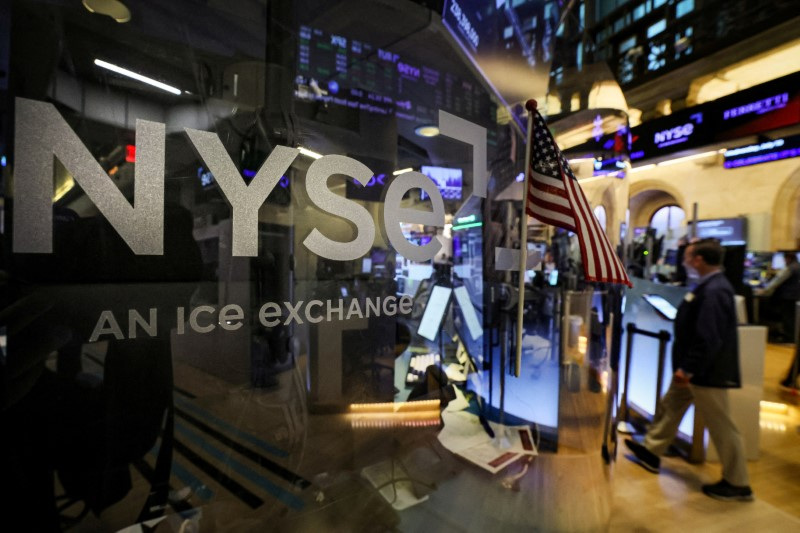By Sinéad Carew and Shristi Achar A
(Reuters) - The S&P 500 and Nasdaq fell on Thursday, with the biggest drag from Apple and a sell-off in chip stocks over concerns about China's iPhone curbs, while a fall in weekly U.S. jobless claims fed worries about interest rates and sticky inflation.
Shares in S&P heavyweight Apple Inc (NASDAQ:AAPL) fell 2.9%, for its second straight day of losses on news that China had widened curbs on iPhone use by state employees, requiring staff at some central government agencies to stop using their mobiles at work.
Bloomberg reported that China planned to broaden the iPhone ban to state firms and agencies.
The drag from Apple, its suppliers and companies with large China exposure pushed the S&P 500 technology sector down 1.6%, making it the biggest percentage decliner among the benchmark's 11 major sectors.
A U.S. Labor Department report showed the number of Americans filing for unemployment claims fell to 216,000 for the week ended Sept. 2, hitting the lowest level since February. But investors worried this would help push the Federal Reserve to continue with tight monetary policy, pressuring stocks.
"The weekly claims was big news this morning, good news being construed as bad news and it's hard to ignore the news out of China" about Apple said Sahak Manuelian, managing director and head of equity trading at Wedbush Securities.
Investors were also warily anticipating inflation readings from August, due in a week.
Due partly to the recent sharp rise in oil prices, Manuelian pointed to "some fretting among investors that inflation might start to pick up again, which isn't crazy."
Bets on the Fed to leave interest rates unchanged in September stood at 93%, yet the chances for another pause in the November meeting were at a much lower 53.5%, according to the CME Group's (NASDAQ:CME) FedWatch Tool.
"There is that very, very small eye of the needle with which the Fed can thread monetary policy that's sufficiently tight, but not so tight that it wrecks the economy. It's a small eye but, it's not completely closed," said Craig Fehr, head of investment strategy at Edward Jones, who called Thursday's decline "a cautious defensive stance."
Minutes before the close, New York Fed President John Williams said it was an "open question" whether monetary policy is restrictive enough to bring the economy back into balance. "We’ve got policy in a good place, but we’re going to need to continue to be data dependent,” he said, pointing to upcoming data releases due before the Fed's September meeting.
The Dow Jones Industrial Average rose 57.54 points, or 0.17%, to 34,500.73, the S&P 500 lost 14.34 points, or 0.32%, to 4,451.14 and the Nasdaq Composite dropped 123.64 points, or 0.89%, to 13,748.83.
The Dow outperformed the S&P and Nasdaq because Apple has a lower weighting in the cyclicals-heavy index, which is price-weighted compared with the market capitalization-weighted S&P 500, where Apple is one of the biggest weights.
Defensive utilities was the biggest gainer among S&P sectors, rising 1.3%, which Edward Jones' Fehr took as another sign of the market's risk-off mood.
The Philadelphia semiconductor index fell 1.98% while shares of Apple suppliers including Skyworks Solutions (NASDAQ:SWKS), Qualcomm (NASDAQ:QCOM) and Qorvo (NASDAQ:QRVO) all fell more than 7%.
Rick Meckler, partner at Cherry Lane Investments said the news from China refocused investors on the idea "that the relationship between the U.S. and China is a big risk to current equity prices, particularly in technology."
Also denting sentiment about the world's second-largest economy, data showed China's exports and imports fell in August.
Shares of U.S.-listed Chinese firms PDD Holdings, JD (NASDAQ:JD).com and Alibaba (NYSE:BABA) fell more than 4% while and Baidu (NASDAQ:BIDU) lost 3.4%.
Also helping to keep the Dow afloat was a 1% rise in McDonald's (NYSE:MCD) shares after Wells Fargo upgraded the stock to "overweight".
Automation software firm UiPath rallied 11.5% on an upbeat annual revenue forecast.
Declining issues outnumbered advancing ones on the NYSE by a 1.80-to-1 ratio; on Nasdaq, a 2.03-to-1 ratio favored decliners.

The S&P 500 posted 13 new 52-week highs and 26 new lows; the Nasdaq Composite recorded 22 new highs and 268 new lows.
On U.S. exchanges 9.76 billion shares changed hands compared with the 10.10 billion moving average for the last 20 sessions.